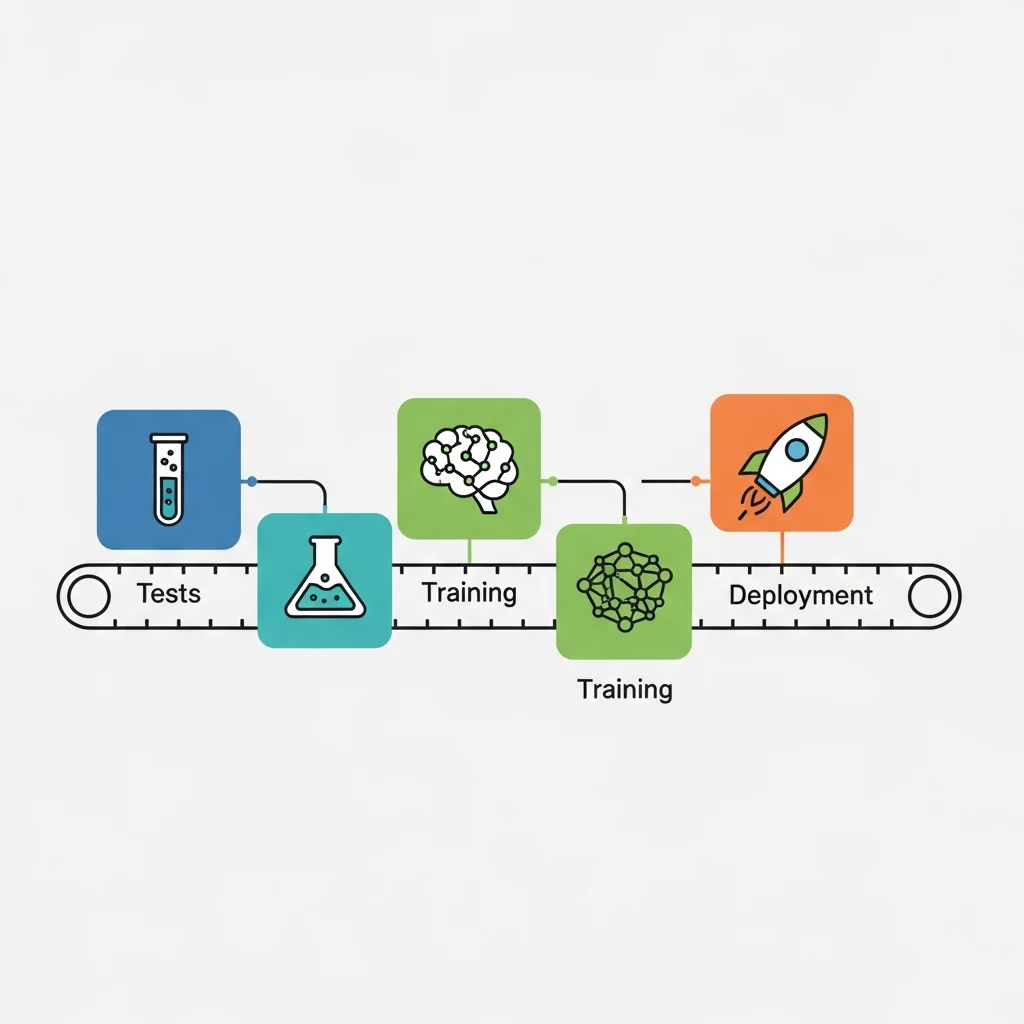Overview
MLOps, a portmanteau of machine learning and operations, is a collection of processes, tools and organisational agreements that support the development, rollout and management of machine-learning models in production environments. The aim of MLOps is to deliver machine-learning solutions in a repeatable, scalable and reliable manner, much like DevOps does for traditional software development.
MLOps focuses on the entire life cycle of an ML model, from data collection and feature engineering through to model training, validation, deployment, monitoring, retraining and retirement. Best practices from software engineering, data engineering and IT operations are used to close the gap between experimental data science and stable production.
Purpose and benefits of MLOps
The primary goal of MLOps is to industrialise machine learning. Many organisations build experimental models but stumble when trying to bring them into production and maintain them. MLOps addresses the following issues, among others:
Models are hard to reproduce because code, data and configurations are not managed systematically.
Deployments are ad-hoc, making it unclear which model version is live at any given moment.
Model performance degrades over time owing to changing data, without timely visibility.
Collaboration between data scientists, software engineers and operations teams is fragmented.
With MLOps, the delivery of ML functionality becomes a continuous process. Models are taken to production more quickly and in a controlled fashion, versioning is clearer, and performance deviations can be detected and resolved early.
Relationship between MLOps and DevOps
MLOps builds on DevOps principles such as continuous integration, continuous delivery, monitoring and feedback loops. There are, however, key differences:
DevOps focuses on application code, whereas MLOps deals with the combination of code, data, features and trained model artefacts.
Training outcomes are not fully deterministic, because changes in data or random initialisation can lead to different model behaviour.
Validation of ML models involves not only technical tests but also statistical performance and fairness criteria.
Typical DevOps concepts such as version control, automated tests, build pipelines and infrastructure as code are extended in MLOps with data versioning, experiment tracking, model registry and model-behaviour monitoring.
Core elements of an MLOps life cycle
Data and feature management
Data forms the foundation of every ML model. In MLOps, data is managed explicitly:
Data is gathered from source systems and stored in data lakes or data warehouses.
Data is cleaned and transformed into features, the input variables for the model.
Both raw data and features are versioned wherever possible so that retraining is reproducible.
Changes in data quality and distributions are monitored, for instance via data-drift detection.
Feature stores are a widely used component in modern MLOps architectures. These systems centralise the definition, documentation and re-use of features for both training and inference.

Model development and experiment management
During development, models are designed, trained and validated. MLOps introduces structure here by:
Placing source code, notebooks and configurations under version control.
Automatically logging which data, hyper-parameters and algorithms were used.
Storing experiment results, such as accuracy scores and loss functions, in a central location.
Comparing and selecting models based on explicit criteria.
Experiment-tracking tools record, for example, which runs were executed with which settings, and which model artefacts were produced. This enables reproducibility and auditability, which is essential in many regulated sectors.
CI/CD for machine learning
Continuous integration and continuous delivery are extended in MLOps to CI/CD for ML, often shortened to CI/CD/CT (where CT stands for continuous training). Key elements include:
Automated tests for data pipelines and model code.
Validation steps that check model quality against predefined metrics.
Pipelines that take raw data all the way to a validated model artefact.
Controlled deployment strategies, such as canary or blue-green deployments, to reduce regression risk.
Many organisations run these pipelines using orchestration tools, for example as jobs in container environments. The result is a predictable, repeatable process that moves from experiment to production.

Deployment and serving
Model deployment is about making ML functionality available to other systems or users. This can be set up in various ways:
Online serving via API endpoints, for example for real-time recommendations or fraud detection.
Batch scoring, where large numbers of records are scored at fixed intervals.
Embedded models in applications or edge devices, such as mobile apps or IoT hardware.
An MLOps environment provides unified version control for models, configurations and dependencies. This makes it easy to roll back to a previous version if issues arise. Container technology is often used to package models within a consistent runtime image.
Monitoring, observability and governance
After deployment, monitoring is crucial. In MLOps we measure not only technical availability but also model behaviour:
Prediction monitoring, for example distributions of model outputs compared with training data.
Data-drift and concept-drift detection, tracking changes in input data and relationships between variables.
Performance monitoring, e.g. by comparing predictions with later actual outcomes.
Fairness and bias monitoring when models influence decisions that impact individuals or groups.
Governance also encompasses access control, audit logging, documentation of decision logic and explainability information on how models reach outcomes. This is becoming increasingly important due to stricter AI and data regulations.

Typical MLOps architecture components
An MLOps architecture usually consists of a combination of the following components:
Source-data storage and data pipelines for extraction and transformation.
Feature store for the definition, storage and re-use of features.
Experiment tracking and model registry for managing models and training runs.
Orchestration platform for pipelines, e.g. for scheduling and dependency management.
Deployment system for rolling out models to production environments.
Monitoring system for both infrastructure and model performance.
Security and governance components such as identity and access management and audit logging.
The exact implementation varies by organisation, depending on existing infrastructure, scale and compliance requirements. Some opt for fully managed cloud services, while others build hybrid solutions on top of existing data platforms.
Roles within MLOps
MLOps is not only a technical approach but also a way of working together. The following roles are often involved:
Data scientists, responsible for model design, experiments and interpretation of results.
Machine-learning engineers, who ensure production-grade implementations of models, pipelines and infrastructure.
Data engineers, optimising data flows, storage and performance.
DevOps or platform engineers, managing the underlying infrastructure and CI/CD processes.
Product owners and domain experts, who formulate functional requirements and acceptance criteria and interpret results.
In mature MLOps teams, responsibilities are clearly divided and workflows are arranged so that hand-offs between phases run smoothly. Documentation and standardised processes play an important role here.
MLOps processes and life-cycle phases
A typical MLOps life cycle comprises the following phases:
Problem definition and data identification, in which the business question and relevant sources are established.
Data preparation and feature engineering, where raw data is cleaned and converted into usable model inputs.
Model development and experimentation, testing various algorithms, architectures and settings.
Validation and selection, assessing models against quality criteria, robustness, fairness and regulatory compliance.
Deployment to production, with controlled rollout and fallback options.
Operational monitoring, including performance, drift and error detection.
Maintenance and retraining, periodically or trigger-based updating of models.
Retirement and archiving, when models no longer meet requirements or are replaced.
MLOps ensures that these phases are not executed just once, but form an iterative, cyclical process.
Challenges in implementing MLOps
Organisations looking to adopt MLOps often encounter a number of recurring challenges:
Tooling fragmentation, where separate solutions for data, experiments, deployment and monitoring are insufficiently integrated.
Lack of standardisation, resulting in each team having its own approach and scripts, which limits scalability.
Culture and collaboration, because data scientists and operations teams have different working styles and priorities.
Compliance and security, especially in highly regulated sectors where traceability and accountability are essential.
Cost and complexity of infrastructure, particularly when multiple environments and models must run in parallel.
Addressing these challenges requires a mix of technical choices, process design and training efforts. Clear guidelines, reference architectures and reusable components can accelerate adoption.
Best practices in MLOps
In practice, several best practices have emerged for an effective MLOps approach:
Put everything that can be version-controlled under version control, including code, configuration, data schemas, features and models.
Automate repeatable steps such as data preprocessing, training, evaluation and deployment.
Define clear quality thresholds for models so that only those meeting the criteria qualify for production.
Treat models as first-class artefacts with explicit life-cycle management and traceability.
Set up monitoring from day one so that both technical and functional issues become visible quickly.
Ensure documentation and knowledge sharing, for example on model purpose, limitations, data used and interpretation of outcomes.
These practices help organise machine learning not as a one-off experiment but as an ongoing capability.
Application areas of MLOps
MLOps is applied across a wide range of sectors and use cases, including:
Financial services, e.g. credit scoring, fraud detection and risk management.
E-commerce, for recommendation systems, price optimisation and marketing personalisation.
Industry and logistics, for predictive maintenance, demand forecasting and route optimisation.
Healthcare, for triage, image analysis and predictive models around patient outcomes.
Government and the public sector, for example in early-warning systems and policy analysis.
In all these domains, the ability to bring models into production reliably and responsibly, monitor them and adapt them is a critical success factor. MLOps provides the organisational and technical foundation to do this at scale.
Summary
MLOps, machine-learning operations, is a discipline that focuses on controlling the full life cycle of machine-learning models. It combines principles from software engineering, data engineering and IT operations into an integrated approach for developing, deploying, monitoring and maintaining models in production.
By systematically managing data, features, code and models and automating processes, MLOps helps organisations move beyond experimentation to apply machine learning sustainably and at scale. Clear role division, appropriate tooling and attention to governance and compliance play a central role.
